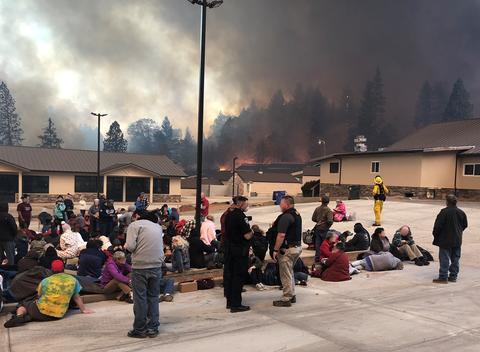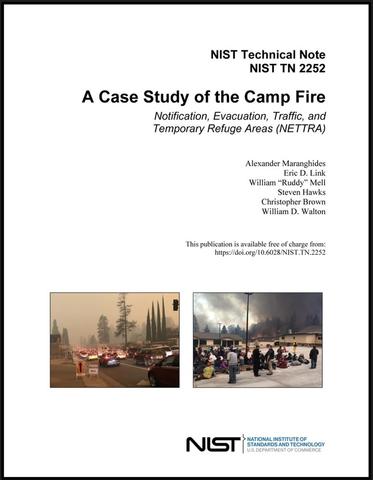Life Safety During the Camp Fire
Notification, Evacuation, Traffic, Temporary Refuge Areas, Rescues, and Fatalities
This portion of the greater case study of the Camp Fire focuses on the life safety aspects of the incident: notification, evacuation, traffic, temporary refuge areas, rescues, and fatalities (collectively, NETTRA). The fire quickly impacted the communities of Concow, Paradise, and Magalia, triggering widespread evacuation of 40,000 people. The fire claimed the lives of 85 people.

The combination of the ignition location, timing, weather, and fuel conditions resulted in little time for communities to evacuate before being impacted by the spreading fire. The heavy traffic volume combined with deteriorating conditions as the fire arrived contributed to the rapid development of widespread gridlock. Routes that took twenty-five minutes in normal traffic took several hours, if they were passable at all. Many people became trapped within the community with no safe egress route. Hundreds of evacuees were exposed directly to hazardous fire conditions in burnover events.
These burnover events, in which people were directly exposed to fire conditions that impacted life safety, including entrapments and near-misses, were identified and documented in NIST Technical Note 2135 (Camp Fire – Fire Progression Timeline). The implementation of temporary refuge areas (TRAs), immediately available areas providing temporary shelter and reduced exposures, was widespread as first responders reacted to the situation and focused on civilian life safety.
The combination of the ignition location, timing, weather, and fuel conditions resulted in little time for communities to evacuate before being impacted by the spreading fire. The heavy traffic volume combined with deteriorating conditions as the fire arrived contributed to the rapid development of widespread gridlock. Routes that took twenty-five minutes in normal traffic took several hours, if they were passable at all. Many people became trapped within the community with no safe egress route. Hundreds of evacuees were exposed directly to hazardous fire conditions in burnover events. These burnover events, in which people were directly exposed to fire conditions that impacted life safety, including entrapments and near-misses, were identified and documented in NIST Technical Note 2135 (Camp Fire – Fire Progression Timeline). The implementation of temporary refuge areas (TRAs), immediately available areas providing temporary shelter and reduced exposures, was widespread as first responders reacted to the situation and focused on civilian life safety.
Over 2600 NETTRA observations and data points were integrated into a spatiotemporal database. Analysis of this data used the foundation of the previously reconstructed fire progression timeline to provide important context to the NETTRA components. Details and the timeline of requested evacuation notifications are presented with respect to fire progression. The evacuation timeline was assessed via traffic observations throughout the region. The rapid and widespread impact of fire on the communities complicated evacuation efforts due to high traffic volume, road closures due to fire and debris, and direct fire exposures to evacuating civilians in numerous burnover events. A total of 31 temporary refuge areas were implemented during the incident, involving more than 1200 civilians. Further, 198 specific evacuation assistance / rescue events were identified, involving at least 1000 civilians. The unique analysis and reconstruction of the NETTRA components of this WUI fire will help at-risk communities prepare for and respond to future incidents.
Camp Fire NETTRA Report
The full report, NIST Technical Note 2252, is divided into two volumes. The main body of the report may be downloaded here. (278 pages, 12 MB PDF)
A supplemental document contains appendices with additional information and supporting data. The supplement can be downloaded here. (306 pages, 24 MB PDF)
NIST CAMP FIRE NETTRA TECHNICAL PUBLICATIONS
- Maranghides A, Link E, Mell W, Hawks S, Brown C, Walton D (2023) A Case Study of the Camp Fire — Notification, Evacuation, Traffic, and Temporary Refuge Areas. (National Institute of Standards and Technology, Gaithersburg, MD), NIST Technical Note (TN) 2252.
nvlpubs.nist.gov/nistpubs/TechnicalNotes/NIST.TN.2252.pdf
- Maranghides A, Link E, Mell W, Hawks S, Brown C, Walton D (2023) Supplement to: A Case Study of the Camp Fire — Notification, Evacuation, Traffic, and Temporary Refuge Areas. (National Institute of Standards and Technology, Gaithersburg, MD), NIST Technical Note (TN) 2252sup.
nvlpubs.nist.gov/nistpubs/TechnicalNotes/NIST.TN.2252sup.pdf


